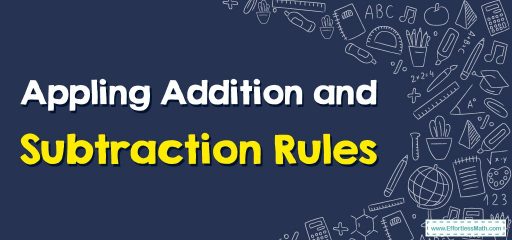How to Apply Integers Addition and Subtraction Rules?
Using the rules of addition and subtraction, two integers can be easily added or subtracted. In this step-by-step guide, you will learn these rules.

Addition and subtraction of integers are two operations we perform on integers to increase or decrease their values. Every number shown on a number line that has no fractional part is an integer.
Related Topics
Step-by-step guide to applying integers addition and subtraction rules
Rules for subtracting integers
The rules for subtracting integers are given below:
- If we subtract \(0\) from any integer, the answer will be the integer itself.
- If we subtract any integer from \(0\), we will find the opposite of the integer.
- Subtraction of integers is done by changing the sign of the subtrahend. After this step, if both numbers are from the same symbol, we add the absolute values and attach the common symbol to it. If both numbers have different symbols, we find the difference between the absolute numbers and put the sign of the bigger number in the result.
Rules for adding integers
Certain rules must be followed to add two or more integers. Integers are complete numbers that do not have fractional parts. This includes positive, zero, and negative integers. The rules for adding integers are as follows:
- The sum of an integer and its inverse is \(0\).
- Adding two positive integers always gives in a positive value that is greater than both integers.
- Adding two negative integers always gives a negative number smaller than the given numbers.
- The addition of a positive number to a negative number is done by finding the difference between the absolute values of both numbers. Then, the sign with the greater number gets attached to the sum.
- Adding integers with \(0\) results in the same number.
Applying Integers Addition and Subtraction Rules – Example 1:
Using the rules for the addition of integers, find which number should be subtracted from \(15\) to get \(-9\) as the answer.
Solution:
Suppose \(x\) must be subtracted from \(15\) to \(-9\). Therefore, we can form an equation in terms of \(x\).
\(15-x= -9\)
\(-x = -9 -15\)
\(-x=-24\)
\(x = 24\)
Therefore, \(24\) has to be subtracted from \(15\) to get \(-9\).
Applying Integers Addition and Subtraction Rules – Example 2:
Subtract \(-8\) from \(-13\) using the rules of subtracting integers.
Solution:
Here we need to subtract two integers with the same sign, \(-13\) and \(-8\).
\(-13- (-8) = -13 + 8\)
\(=-5\)
Exercises for Applying Integers Addition and Subtraction Rules
Perform the following calculations using the addition and subtraction rules.
- \(\color{blue}{(-5)+9}\)
- \(\color{blue}{-11-19}\)
- \(\color{blue}{8 – 10 +(-4) + 7}\)
- \(\color{blue}{(-16) + (-24)}\)
- \(\color{blue}{(-3)-(-5)-(-12)}\)

- \(\color{blue}{4}\)
- \(\color{blue}{-30}\)
- \(\color{blue}{1}\)
- \(\color{blue}{-40}\)
- \(\color{blue}{14}\)
Related to This Article
More math articles
- The Ultimate TASC Math Course (+FREE Worksheets & Tests)
- How to Use Properties of Numbers to Write Equivalent Expressions?
- The Best Calculators for Grade 9 Students
- The Ultimate 7th Grade OST Math Course (+FREE Worksheets)
- How to Divide Rational Expressions? (+FREE Worksheet!)
- Average Value of a Curve
- Top 10 HSPT Math Prep Books (Our 2023 Favorite Picks)
- How to Define Limits Analytically Using Correct Notation?
- 5 Of the Best Scientific Calculators
- How to Factor Polynomials?


























What people say about "How to Apply Integers Addition and Subtraction Rules? - Effortless Math: We Help Students Learn to LOVE Mathematics"?
No one replied yet.